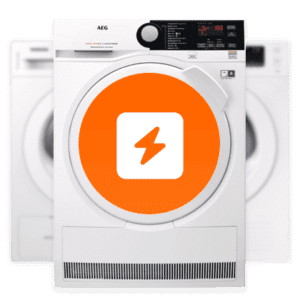How much energy does a dryer use?
Of course, the most energy-efficient way to dry your laundry is to hang up your clothes, towels and bedding. This doesn’t cost you any electricity at all and is therefore the best option for your energy bill and the environment. However, drying on a drying rack or line does have its drawbacks. It generally takes longer for your laundry to dry, the sun can damage it, and it can take up a lot of space. If you don’t have the time or inclination to wait, or if you don’t have space to hang up your laundry, a tumble dryer can be a great solution.
‘How much energy does a tumble dryer use‘ is your question? Of course, that varies from one appliance to another. Technology seems to be getting better every year, making clothes dryers more and more energy efficient. Exactly how energy-efficient a tumble dryer is depends largely on the type of tumble dryer and its energy label. You can also look at the energy costs per year. We will be happy to explain all of this to you.
Types of dryers
There are currently three different types of dryers on the market: the heat pump dryer, the condenser dryer and the vent dryer. Of these three types, the heat pump dryer is the most energy efficient. This is because it uses a heat pump and a coolant during the drying process, which creates a relatively low drying temperature. Because of this lower temperature, the power consumption remains low, and your clothes stay beautiful longer. The average heat pump dryer is unfortunately more expensive than most other dryers. However, because they use so much less energy, a good heat pump dryer is often cheaper than a regular condenser or extractor dryer.
The condenser dryer comes in second when it comes to energy consumption. It uses a condenser and an electric heating element. This dries your laundry faster, but uses more power and will wear out your clothes faster.
The clothes dryer uses the most power when drying. This is a somewhat outdated type of dryer, which is why we do not recommend purchasing airflow dryers.
Energy Label
The energy label gives you an indication of how energy efficient your dryer is. In the Netherlands, a new tumble dryer needs at least label B. Dryers with energy label C or lower may no longer be sold. In most cases, heat pump dryers have energy label A++ or A+++, which means that they are energy efficient. The condenser dryer often has energy label B or energy label A, and is therefore not considered an energy-efficient dryer.
Washers with a good energy label are often also more expensive to buy than a less efficient dryer. This deters some from going for an energy-efficient clothes dryer. However, because they keep your energy costs so much lower, this is ultimately the cheaper choice. Think of it as an investment!
Energy cost per year
Most dryer manufacturers and suppliers also list the energy cost per year of each dryer. Many heat pump dryers have energy class A+++, but that doesn’t mean they all use the exact same amount of energy. By looking at the energy consumption per year, you can make a comparison between different heat pump dryers and find the most energy-efficient one.
Handful tips for more energy-efficient drying
Drying your laundry using a tumble dryer consumes a lot of power. Of course it is much more economical to hang your laundry, but this is not an option for everyone. That’s why we have put together some tips on how to dry your laundry more energy-efficiently using a tumble dryer. Energy efficient drying is not only good for the environment, but also for your wallet as it keeps your energy costs down. The fill weight of a dryer indicates the maximum amount of laundry that can fit in the drum at one time. By filling the drum to the maximum, you get the most out of your drying time and power consumption. Note: Do not exceed the maximum fill weight! This can damage your dryer and may prevent it from drying properly or evenly.
Redeem your old dryer
It may not sound very economical or sustainable to replace your old dryer when it is still working fine, but it may be using much more power per drying cycle than it should. Want to use less power? Then replace your old dryer for an energy-efficient one, in some cases you can save up to 100 euros per year.
A cheap tumble dryer may sound like a good deal, but often you will end up paying more. If dust builds up in the lint filter of your dryer, it has to work harder (and use more energy) to get your laundry dry. It also increases the risk of fire. Cleaning the filter regularly helps your dryer to work better, last longer and reduce your energy consumption.
The filter should be cleaned at least once a year.

